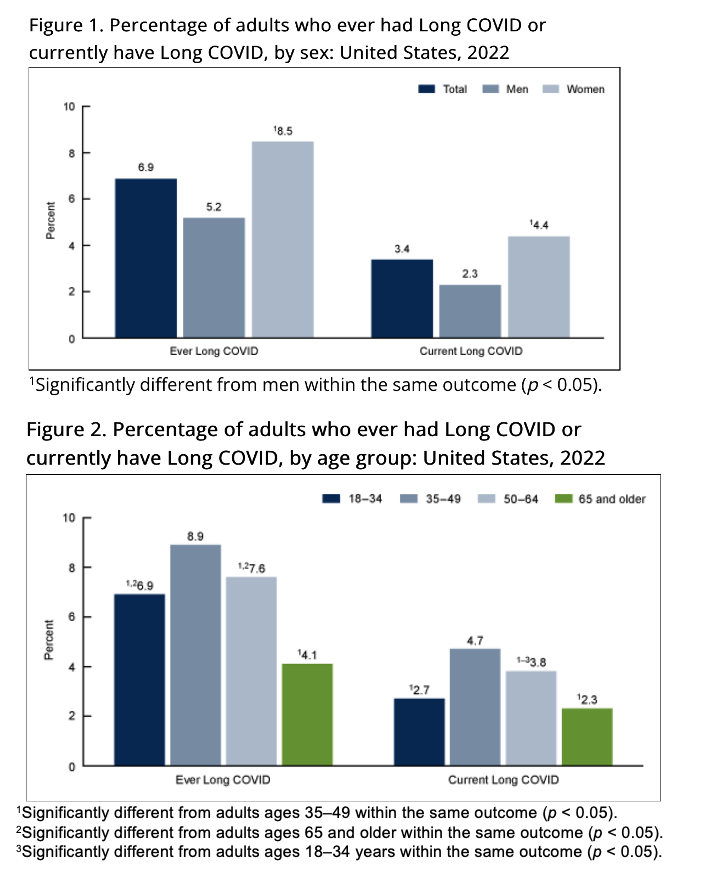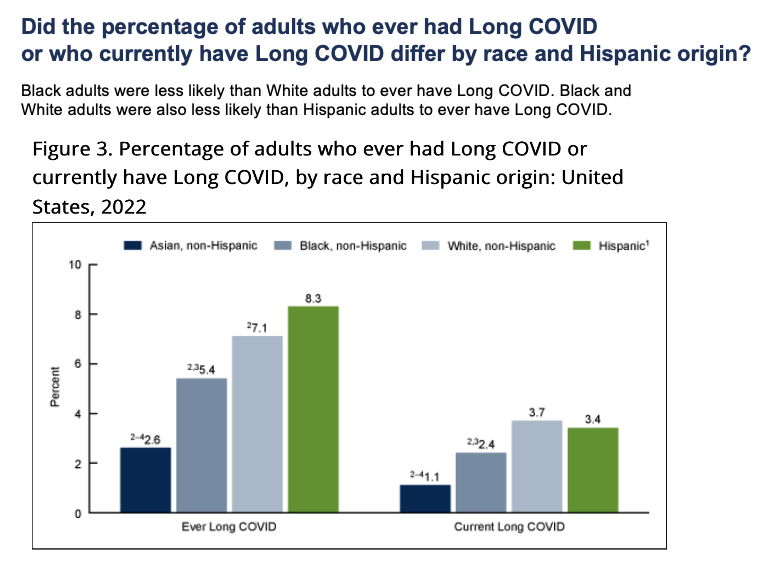| |
CDC: Long COVID in Adults: United States, 2022
|
| |
| |
Download the PDF
Key findings
Data from the National Health Interview Survey
• In 2022, 6.9% of adults ever had Long COVID and 3.4% had Long COVID at the time of interview (currently have Long COVID); women were more likely than men to ever have or currently have Long COVID.
• Adults ages 35-49 were the age group most likely to ever have (8.9%) or currently have (4.7%) Long COVID.
• The percentage of adults who ever had or currently had Long COVID varied by race and Hispanic origin.
• Adults with family incomes at 400% or more of the federal poverty level were less likely than those with family incomes at 200%-399% to ever have or currently have Long COVID.
• The percentage of adults who ever had Long COVID was lower in large central metropolitan areas compared with medium and small metropolitan and nonmetropolitan areas. Current Long COVID was lowest in large central metropolitan areas.
People who have had COVID-19 may continue to have symptoms or develop new symptoms months after being infected with SARS-CoV-2 (1). This can lead to long-term health and economic impacts on those affected and on society (2). This report uses data from the 2022 National Health Interview Survey to describe the percentage of adults who ever had or had Long COVID at the time of interview (currently have Long COVID) by sociodemographic and geographic characteristics. Long COVID was defined as self-reporting the presence of symptoms for at least 3 months after having COVID-19 among those who reported either a positive test or a doctor’s diagnosis of COVID-19.
Summary
In 2022, 6.9% of adults ever had Long COVID and 3.4% of adults currently had Long COVID. For both outcomes, prevalence estimates were higher among women compared with men, adults ages 35-49 compared with other age groups, and adults living in more rural areas compared with those living in large central metropolitan areas. Prevalence estimates were lower among Asian adults compared with other racial and ethnic groups, and adults with family incomes of 400% or more of the federal poverty level compared with those with incomes from 200% through 399% of the federal poverty level.
Data from the Nationwide Blood Donor Seroprevalence Survey suggest that 77.5% of people ages 16 and older had antibodies indicating a previous COVID-19 infection as of December 2022 (3). Adults ages 65 and older and Asian adults were least likely to have antibodies for the virus that causes COVID-19.
For adults, an estimated 6.9% ever had long COVID and 3.4% currently had long COVID that year, said Dzifa Adjaye-Gbewonyo, PhD, MPH, of the NCHS, and colleagues.
The adult findings generally align with earlier CDC data which showed that the prevalence of long CIVID fell from 7.5% in early June 2022 to 6.0% in mid-June 2023.
As for adults, women were more likely than men to ever have had long COVID (8.5% vs 5.2%) and to currently have long COVID (4.4% vs 2.3%), Adjaye-Gbewonyo and colleagues reported.
Adults ages 35-49 were more likely than all other age groups to ever have had long COVID (8.9% vs 6.9% for those ages 18-34, 7.6% for those ages 50-64, and 4.1% for those ages 65 and up). Similar patterns were seen for those who currently had long COVID (4.7% vs 2.7%, 3.8%, and 2.3%, respectively).
Asian adults were less likely than Black, white, and Hispanic adults to ever have had long COVID (2.6% vs 5.4%, 7.1%, and 8.3%), and the same goes for currently having long COVID (1.1% vs 2.4%, 3.7%, and 3.4%).
Adjaye-Gbewonyo and colleagues noted that data from the Nationwide Blood Donor Seroprevalence Survey suggested that 77.5% of people ages 16 and older had antibodies indicating a previous COVID infection as of December 2022.


|
|
| |
| |
|
|
|